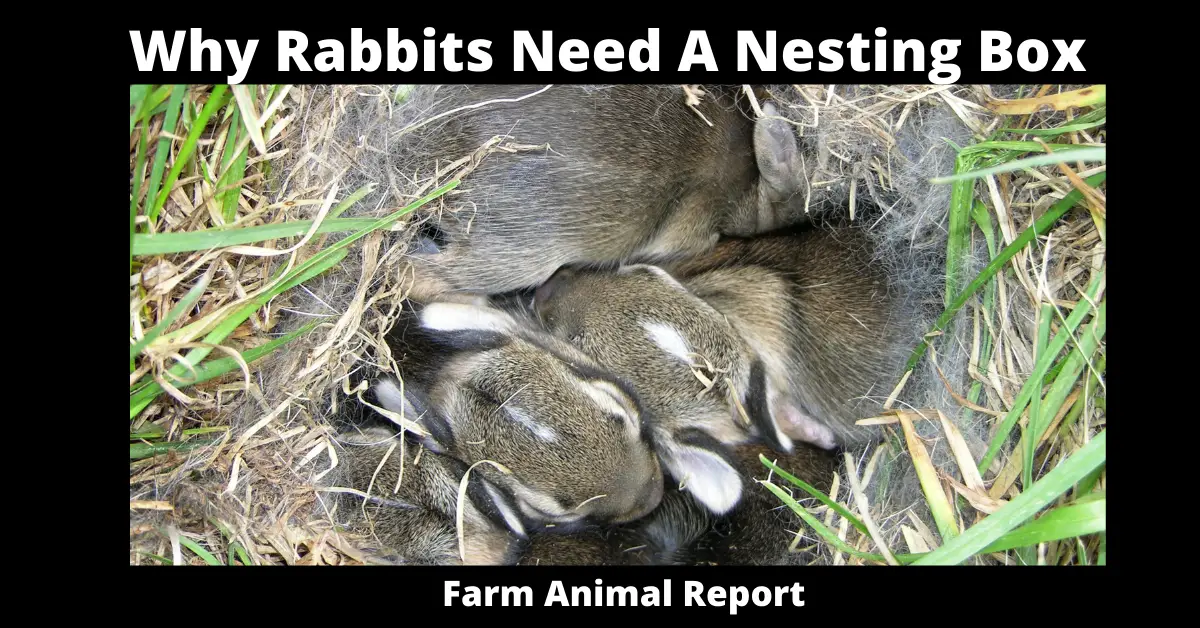Do Rabbits need a Nest Box?
As a general rule the use of a Rabbit nesting box 1) Keeps infant Kits from wiggling away from warmth 2) Keeps the kits where they can get to the does milk 3) Protects the baby rabbits from Predators. The use of a Rabbit Nesting box will greatly increase the survival rate in your litter.
Do Rabbits need a Nest Box – The rabbit’s nest box is primarily used to enclose the offspring and provide them with additional safety. Rabbits in the wild will dig a hole in the ground and build a shelter to defend themselves from predators and harmful elements.
A nesting box is a must if you have a pregnant doe at home. These nesting boxes are modeled after the burrows where rabbits give birth in the wild and are often smaller than the rabbits themselves, with grasses to create a safe and comfortable environment for the baby rabbits to be born in.
Before she gives birth, your doe wants a rabbit nesting box in her cage. At roughly 28 days gestation, a few days before she gives birth, place this in their hutch. If you put the nesting box in too soon, she won’t know what it’s for because her maternal instincts haven’t yet kicked in.
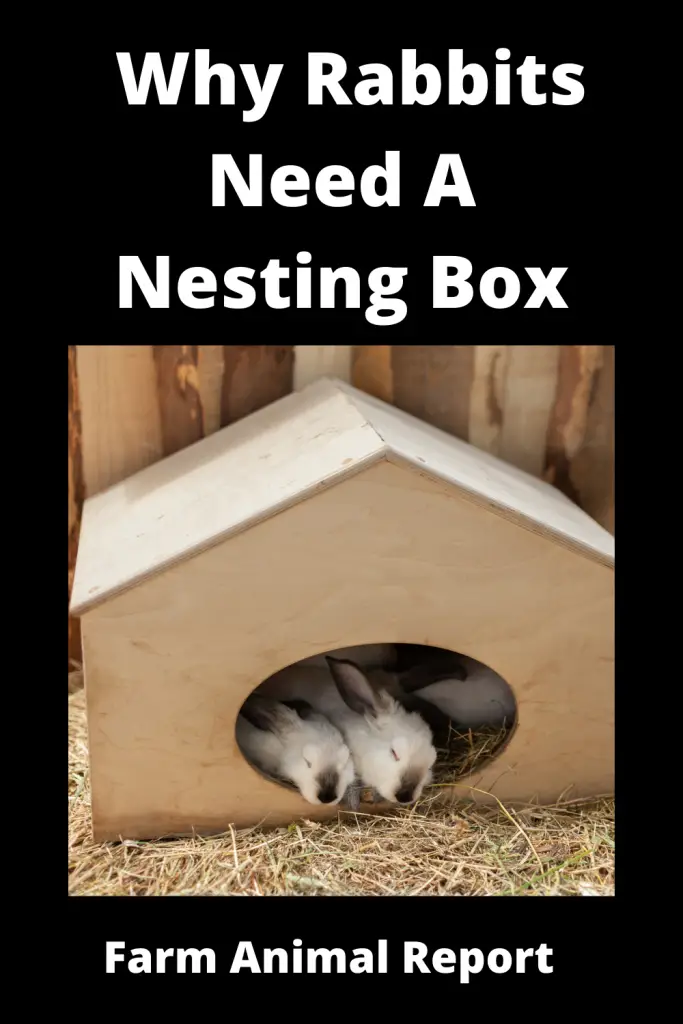
You can also Read our Guide –18 Ways to Make Money by Rabbit Farming—Extensive Guidelines for Rabbit Farmers
What is a Rabbit Nesting Box?
A rabbit nesting box is an isolated structure, usually, a square box made up of wood, plastic, or metal in which rabbits give birth to their offsprings and nourish them with proper care.
Check Out Amazon for Resources about Breeding Rabbits
Rabbit Nesting Boxes Types
Rabbit nesting boxes come in a variety of shapes and sizes. It will be up to you to choose which type is right for your rabbit. This is frequently determined by whether they are using it for childbirth or simply as a hangout spot!
Here are some of the materials from which rabbit boxes are made:
1. Wood
Your rabbit will feel most at ease in a wooden nesting box. Wood, on the other hand, can be more challenging to clean and disinfect. For mother rabbits and their kits, a clean environment is essential.
2. Plastic
If you’re anxious about keeping your nesting box clean, a plastic nesting box is a fantastic option. They’re a lot easier to keep clean. They aren’t always as durable, and they don’t always feel as natural to your rabbit.
3. Metal
Metal rabbit nesting boxes have two advantages: they’re easy to clean, and they’re solid and long-lasting. Mother rabbits, on the other hand, do not find them particularly natural.
4. Grass
A grass rabbit nesting box is less popular, and it’s more typically utilized as a hideaway and play area for your rabbit than as a spot for a doe to give birth. They are, however, entirely edible and beneficial to your rabbit’s teeth and digestive system because they are comprised of hay and grass.
In Nature, what do Rabbits use?
In Nature, Rabbits dig burrows deep into soft soil. In which they give birth to young ones. They also use soft grass and other material for bedding purposes deep inside the holes. Also, in the wild, the doe would place grasses she found in her nesting area, making it soft and warm before placing a final layer of her fur pulled from her body.
Nest Box Timeline
Always place the nest box two to three days before the mother is expected to give birth to her brood. It’s impossible to predict if she’ll give birth early or not. If you put it in soon enough, the doe will begin to use the nesting box as a restroom, as long as there isn’t too much waste within the box. A few pebbles are acceptable, but not excessively so.
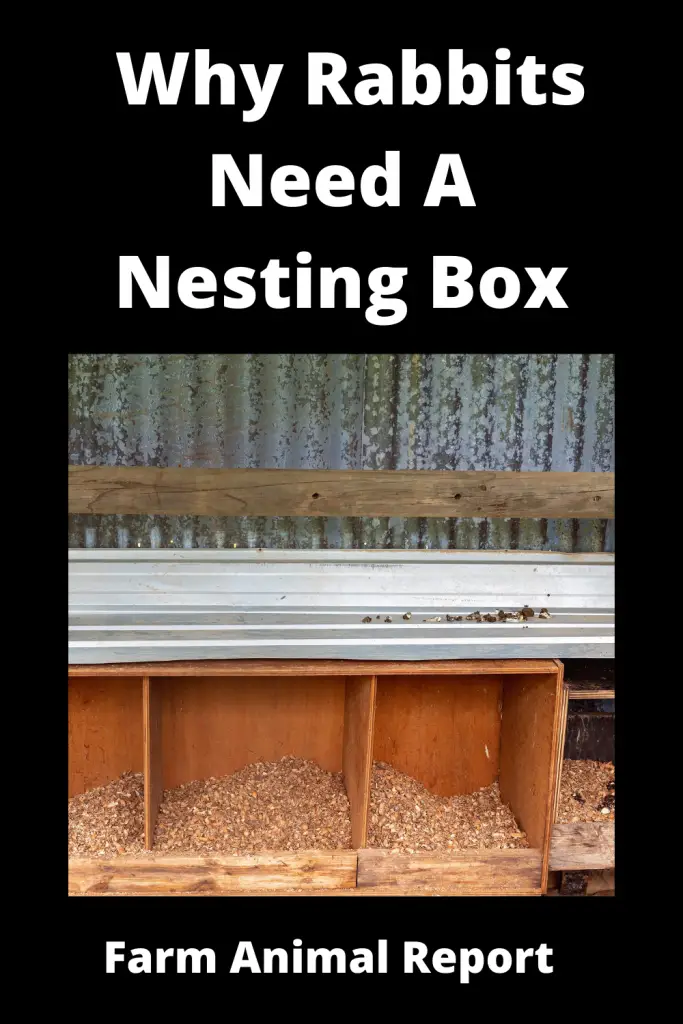
Rabbits will nest fluff and create the nest according to their preferences with whatever they have. It doesn’t matter if it’s made of bedding, cardboard, newspaper, or straw. The mommas will then use their own fur to line the nest. If she has begun to pull her coat, she is most likely within 24 hours of giving birth.
Lop Rabbit youngsters usually don’t come out of the nest box until they are three weeks old, but if they seem to be handling the wire reasonably well on their own, I remove the nest box if the weather is nice enough. They’ll eventually start using the nest box as a toilet, and it’s more sanitary for them to remove it than to leave it there for them to make a mess.
Consider The Factors Before Buying a Rabbit Nesting Box
When buying a commercial rabbit nesting box, there are a few things to keep in mind to ensure you obtain the perfect one for your rabbits.
1. Size
The size of the rabbit nest box is the most significant consideration. These nesting boxes are typically not much larger than they do, and they only require enough space to move and turn around in. If it’s too big, the rabbits won’t feel protected, and they’ll have trouble keeping their offspring warm.
If you’re utilizing a nesting box as a sleeping or playing area for your rabbits, though, the size is entirely up to you! You may want to give them ample space to relax in, or you may wish to provide them with a smaller area to rest in.
What is the best size for a Rabbit Nesting Box?
More than anything else, the size of your doe will determine nesting box size. For French lops and other giant rabbits, it appears that having a box large enough for two Mamas to sit close to each other in the nesting box is the best option. So it’s around the size of two adult rabbits. It’s not that the babies require so much room. When you create more giant boxes, the mom stepped on considerably fewer babies when she leaped in to nurse them.
2. Materials: What can Nesting Boxes be made from?
As previously discussed, there are a variety of materials from which to construct your rabbit nesting box. Wood, plastic, metal, and grass are the most frequent, while the wire is also used in some DIY nesting boxes. The material of your rabbit nesting box will be determined by your rabbit’s preferences as well as a few other considerations, such as cleaning.
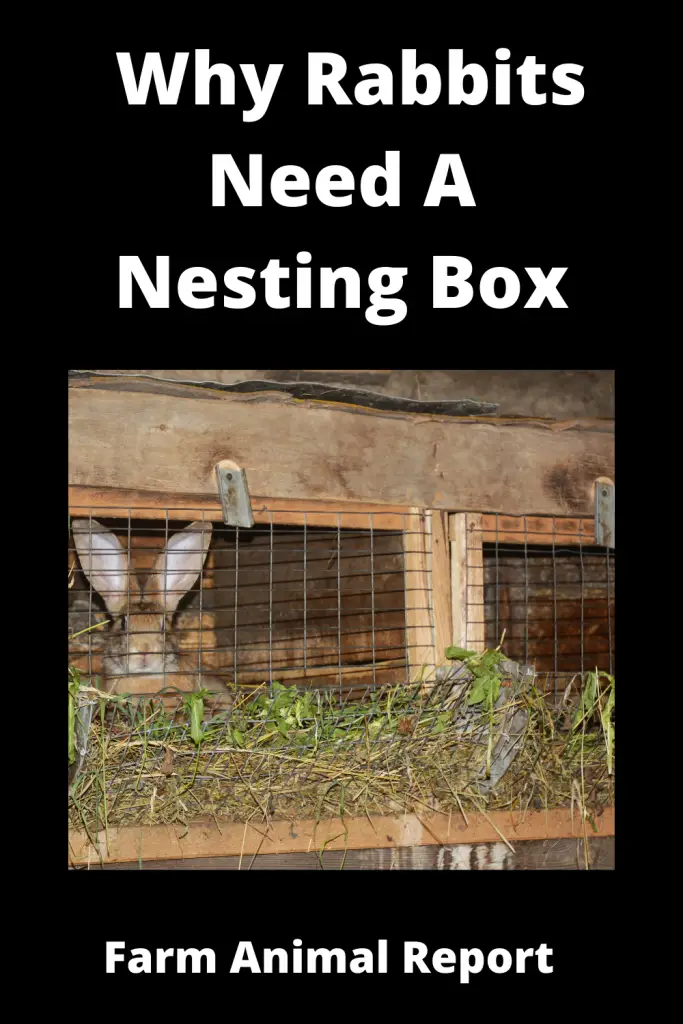
3. Purpose
If your rabbit is expecting a baby, the nesting box must be large enough to accommodate them. It must be the appropriate size and material for them to feel comfortable.
4. Rabbit Box Longevity
A rabbit nesting box will be useless if it is readily broken! Look for something solid and long-lasting that will protect your bunny. Keep in mind that a rabbit nesting box must be kept in the rabbit cage for up to 3 weeks after your doe has given birth.
5. Warmth
You want your rabbit to feel safe and secure within the rabbit nesting box, no matter what you’re using it for. This is especially crucial if your rabbit is giving birth, as the kits must be kept at the proper temperature. If your rabbit lives outside, a rabbit nesting box might help them stay warm during the winter months.
Nesting Box for Breeding Rabbits?
As we discussed above, nesting boxes for breeding rabbits are also available commercially.
DIY – If you want to make your own rabbit nesting box, here is how you do it:
- You’ll need a commercial nest box if you’re utilizing all-wire cages. Wood boxes or wire boxes with heated interiors are suitable in the coldest areas. Metal nest boxes are what we use. They appear to be more sanitary because you can dismantle them and scrub, if not sanitize, them with bleach. Dr. Williamson, a rabbit expert, advises that by dislodging all organic particle matter after using the nest box, you can eliminate any germ-friendly stuff and that the wooden nest boxes are safe to use re-use.
- Clean the nest box well after using it with the last doe. You must scrub the nest box thoroughly to remove any lingering organic material, then spray it with a robust bleach solution (1:10) and let it sit for half an hour before thoroughly rinsing both the box and the box floor.
- Fill the bottom of the nest box with 1 to 2 inches of pine shavings. One inch is sufficient in the heat. Use 2 inches or so in the winter.
- Fill the nest box with straw until it reaches the top. The straw will help insulate the kits and will be chewed by the doe.
- Squeeze some timothy or field hay into the rabbit nest box’s very top.
- Make a tiny burrow with your fist in the middle of the rabbit nest box. Push your right fist to the shavings, but not all the way. People don’t believe they require the suggestion, but it may make their job easier.
- Finally, place the nest box in the cage of the doe. Because you’ll need to check on the baby bunnies regularly (preferably every day), locate the nest box where it’s easy to reach.
After that, you’ll put the rabbit nest box in the cage and watch the doe.
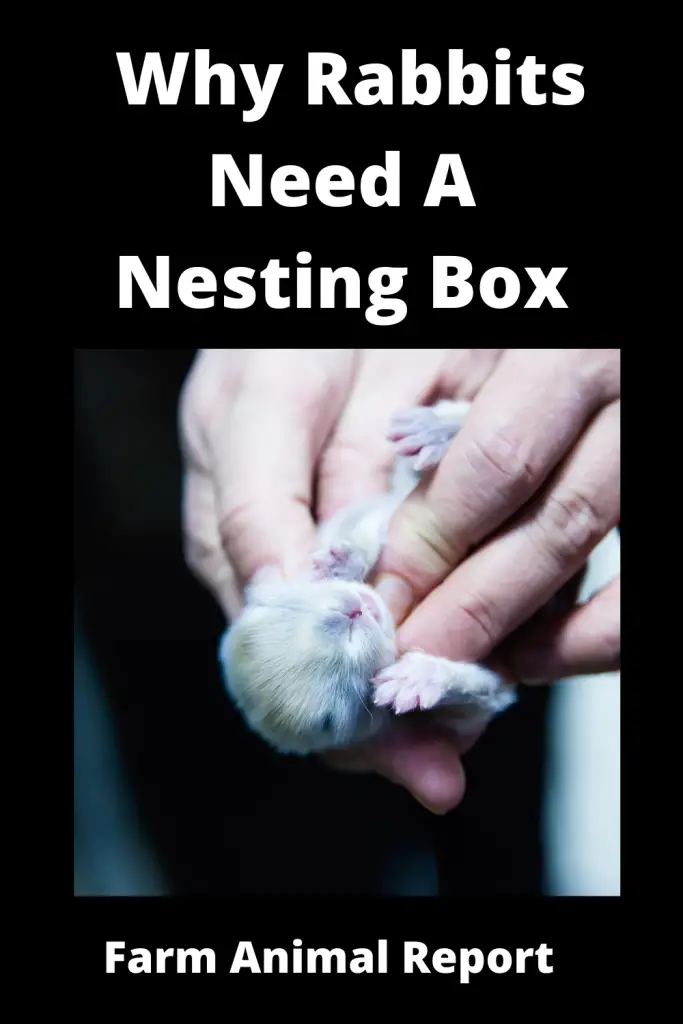
She’ll perform one of the following:
- All she’ll do is stare at you incredulously. She’s deceiving you; she doesn’t want you to know she’s on the verge of giving birth. Some do nothing except sniff the rabbit nest box and lie down.
- Some do have the mellowness of jello. They’ll take a piece of straw or hay and start chewing, happy as can be.
- Some doe stares at you as if, “Oh, my goodness! Why did it take you so long?” They’ll dive right into the nest and begin dismantling all of the gorgeous layers and thick shavings carpet. They’ll cram as much straw as they can into their mouths and pace the cage, looking for the ideal spot to make their nest.
Do Bucks Need a Nesting Box?
Usually, if you provide an extended open area for your rabbits, Bucks do not need a Nesting Box. But in community cages/nesting boxes Bucks and Doe live together with babies. So, if you provide them Nesting box, there won’t be an issue.
Do Baby Rabbits Need a Nesting Box?
Yes, baby rabbits must need a nesting box for proper care and management. Rabbit owners must care for their baby rabbits while they are in the nesting box.
The first two weeks of a baby rabbit’s life are pretty simple to care for. All of the feeding and washing of the kits will be done by the mother rabbit.
It will be your responsibility to keep the rabbit nest box clean and dry, as well as to feed the doe and her kits.
How many Baby Rabbits can Live in the Nesting Box?
It depends upon the dimensions/size of the box, along with the size of the rabbit.Rabbits have an average litter size of five, yet moms can have as few as one and as many as twelve! Due to the rapid growth of young bunnies, “doe” rabbits can produce three or four litters in a season.
When do Baby Rabbits leave a Nesting Box?
Usually, baby rabbits do not leave the box. Their mother kicks them out for several reasons, which are discussed below in this article. Also, the baby rabbit only goes to the box if he/she remains to attach to the mother’s nipple and she comes out of the nest. Some time baby rabbits cripple out due to temperature or feeding purpose.
Nesting Box Alternatives
There are many alternatives to nesting box such as:
- Provide an open area and natural environment with leaves and soft bedding as rabbits do nesting in the wild.
- Use a cardboard box as a nesting box. You can also put softwood shavings in the bottom of the box for moisture absorption, then add timothy or grass hay to it for bedding.
- Make a tunnel with a plastic or card box. This tunnel should have bedding on the sides, top and bottom. At the back, move the bedding around, so the tunnel opens to a small, private space. This type of nest most resembles what a wild rabbit would build.
What should be in a Rabbit Nesting Box?
When filling a rabbit nesting box, begin by placing a clean corrugated cardboard pad on the bottom of the box that has been trimmed to fit the size of the floor. After that, fill the container with half an inch of wood or pine shavings, followed by any type of soft grass hay. The hay should be piled high in the box to keep them warm and comfortable! Bermuda grass or alfalfa hay is frequently recommended.
Your doe will pull fur from her own body as she prepares to give birth, precisely as she would in the wild. She’ll fluff the body coat into a cotton-like lining with her breath, insulate the box, and create the ideal environment for her bunnies!
How do Breeding Rabbits use a Nesting Box?
She will generally gather hay or straw in her teeth and pluck fur from her chest to line the nest just before the doe kindles. This can happen several days in advance, but many people, especially first-time mothers, wait until the last minute. She should give birth in the nest rather than on the cage’s wire floor. If you discover young ones outside the nest box, dry them thoroughly before transferring them to the box as soon as possible.
Even if the kittens aren’t moving, it’s worth attempting to renew them because stimulation and warmth can often save their lives. This isn’t always an indication that the mother rabbit has rejected the young ones, and she may go on to appropriately care for them after that. If she doesn’t, the only options are to foster them or try to bottle feed the kits to another doe with a litter. Bottle feeding frequently does not yield positive results.
For starters, no commercially available supplement is designed to replace rabbit milk. Fostering out the kits, on the other hand, can produce excellent outcomes if the young ones are only a few days apart in age. Mother doesn’t mind taking in new young ones, and if you time it correctly, you may put the foster kits in the nest box with her offspring before she returns to feed so that the new young ones will smell like the rest of the litter to her.
Ensure, however, that the foster mother has adequate nipples to provide the additional babies. It’s critical not to overburden her with too many, as she won’t be able to offer them adequately.
Why do Breeding Rabbits push a Baby Rabbit out of Nesting Box?
There are many reasons for doing that, such as:
- If babies are too weak and the mother knows they cannot survive, then she kicks them out.
- If the “nesting instinct” of the mother rabbit kick in, she tries to dig a burrow. She has no clue that there are kits in there, and she may stomp on them or damage them while digging.
In that situation, put the kits in another container with bedding and fur until this evening, and then bring them out to her so she can nurse. Remove them from the nest again until morning or when her digging behavior stops. - Personal preference is another cause that leads to this unusual behavior of mother rabbits.
- Bad habits of your doe are also a reason.
- The first-time mother also sometimes does this because she is not very good at nursing.
- Nutritional imbalance or off-feeding also leads to the kicking out or killing of babies.
To counter all these, you must introduce the mother to the litter only during feeding time and then remove her to a separate nesting box
Health Problems associated with Nesting Boxes
Some of the health issues due to nesting boxes are snuffles and hairball accumulation, and physical injury if any wire or sharp edge is present in the box.
• Snuffles (Pasteurellosis)
Cause and clinical signs
If you introduce or have an infected rabbit in the cage, the Pasteurella multocida bacterium can readily be transferred to other cage rabbits. The bacterium can cause discharge, redness, and squinting in the eyes and nose (sneezing, discharge), earning the sickness the nickname “snuffles.” Pasteurella can also infect other parts of the body, including the ears (causing a head tilt), abscesses (which appear as lumps on the skin), and uterine infections.
Preventative measures
Some bacteria types remain dormant in the rabbit’s nasal canal until the immune system is stressed, such as when a new diet or pet is introduced or when the rabbit is overcrowded. Infected rabbits should have their stress levels reduced, and new rabbits should be quarantined to prevent the disease from spreading or recurring.
Treatment
Antibiotics are used for a prolonged and sometimes recurrent course of treatment. If an abscess develops, surgery may be required.
• Hairballs (Trichobezoars)
Causes and symptoms
Hair is usually found in a rabbit’s stomach as it grooms itself. The grooming behavior of rabbits is affected by cage conditions such as food, temperature, lighting, and comfort. Hair must be able to pass through the intestine because rabbits cannot vomit. If it can’t, it will restrict the flow and cause significant problems. Hairballs are so frequent that they should always be considered an issue in any rabbit that is sluggish or refusing to eat.
Nesting Tips
- It’s wholly up to you what you put in it for nesting material; pet parents prefer straw, but when the temperature is particularly humid, use Pine bedding primarily as long as the weather is warm enough. The straw will absorb water from the air and become quite sticky, drenching the babies.
- Because pine bedding does not absorb water as well as cotton bedding, you must ensure that the bedding in the nest box is deep enough for the infants to sit above their waists and that pee has a place to go.
- If the temperature and weather cooperate, you shouldn’t have to clean out the nest box more than once a week or two.
Final Thoughts
A nesting box can be a fantastic addition to your rabbit’s home, even if they are not pregnant or preparing for the delivery of babies. As mentioned above, it is similar to a burrow for rabbits and closely resembles the existence they would have had in the wild. It also serves as a perfect location to hide, slumber, rest, and remain warm, which is vital if your bunny is outside in a cold area.


